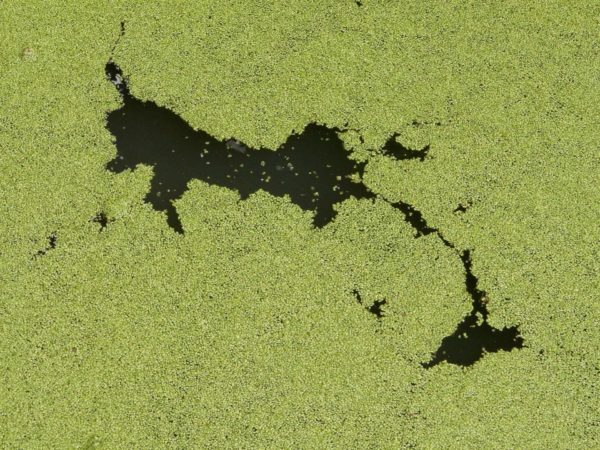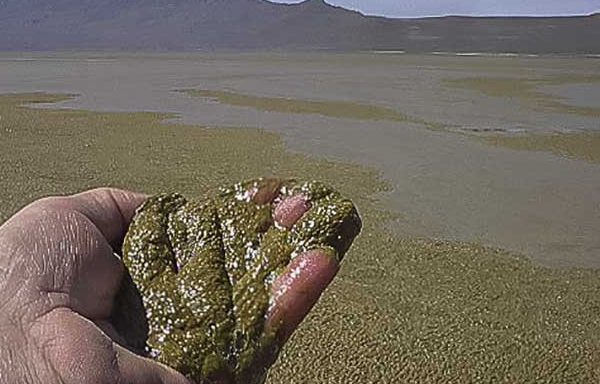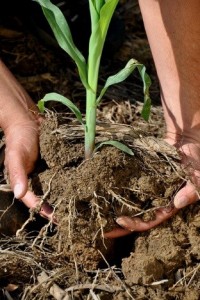



When there is a combination of population increase, wastewater discharge, agricultural fertilization and climate change, the cocktail is detrimental to humans and animals. The harmful cocktail produces harmful algal blooms, and many of these are toxic to humans and wildlife.
Wayne Wurtsbaugh, Professor Emeritus in the Watershed Sciences Department at Utah State University, along with Hans Paerl and Walter Dodds published a global review of conditions that lead to these harmful algal blooms in rivers, lakes, and coastal oceans. Wurtsbaugh says the review will be an excellent resource for students studying pollution and for managers wanting to review recent advances in this field of study. Their review highlights how agricultural, urban and industrial activities have greatly increased nitrogen and phosphorus pollution in freshwater and marine systems. This pollution has degraded water quality and biological resources costing societies billions of dollars in losses to fisheries, the safety of drinking water, increases to greenhouse gas emissions and related social values. The findings have been published in, “Nutrients, eutrophication and harmful algal blooms along the freshwater to marine continuum.”
The scientific review highlights that although individual bodies of water may be more effected by increases in either phosphorus or nitrogen, the unidirectional flow through streams, lakes and into marine ecosystems creates a continuum where both nutrients become important in controlling the algal blooms. The authors report how increasing nutrients has caused harmful blooms in waters as diverse as Utah Lake (Utah), mid-west agricultural streams and the Gulf of Mexico where a 5,800 mi2 (15,000 km2) dead zone has developed. The authors conclude that although the specifics of algal production varies in both space and time, reducing the human causes of both phosphorus and nitrogen may be necessary to decrease the harmful algal blooms along the freshwater to marine continuum. These algae blooms make waters dysfunctional as ecological, economic and esthetic resources.
The technology currently exists to control excessive nutrient additions, but more effective environmental regulations to control agricultural nutrient pollution and investment in more advanced wastewater treatment plants will be needed to reduce these inputs and improve water quality. The enhancement of the quality of freshwater and coastal systems will become essential as climate change and human population growth place increased demands for high quality water resources.
Read the paper: WiresWater
Article source: Utah State University
Image: Utah State University
For Africa to end chronic hunger, governments must invest in sustainable water supplies.
The fields are bare under the scorching sun and temperatures rise with every passing week. Any crops the extreme temperatures haven’t destroyed, the insect pests have, and for many farmers, there is nothing they can do. Now, news about hunger across Africa makes mass media headlines daily.
Globally, hunger levels are at their highest. In fact, according to the Famine Early Warning Systems Network, over 70 million people across 45 countries will require food emergency assistance in 2017, with Africa being home to three of the four countries deemed to face a critical risk of famine: Nigeria, South Sudan, Sudan and Yemen. African governments, non-governmental organisations (NGOs) and humanitarian relief agencies, including the United Nations World Food Programme, continue to launch short-term solutions such as food relief supplies to avert the situation. Kenya, for example, is handing cash transfers and food relief to its affected citizens. The UN World Food Programme is also distributing food to drought-stricken Somalia. And in Zambia, the government is employing every tool including its military to combat insect pest infestation.
But why are we here? What happened? Why is there such a large drought?
Many African smallholder farmers depend on rain-fed agriculture, and because last year’s rains were inadequate, many farmers never harvested any crops.
Indeed, failed rains across parts of the Horn of Africa have led to the current drought that is affecting Somalia, south-eastern Ethiopia and northern and eastern Kenya.
Then, even in the countries where adequate rains fell, many of the farmers had to farm on depleted soils, and consequently, the yields were lower. Degraded soils and dependence on rain-fed agriculture coupled with planting the wrong crop varieties are some of the fundamental problems that lead to poor harvests and then to hunger. Worsening the situation is the unpredictable climate. Given these fundamental and basic issues that fuel the hunger cycle in Africa, it naturally makes sense to tackle them.
It is not rocket science. Farming goes hand-in-hand with water. There can be no farming without it. While this seems easy to reason, there are few organisations working to make sure that African farmers and citizens have access to permanent water sources. Access to water sources all year round would ensure that farmers can farm year in and year out.
African governments must, therefore, invest in ensuring that their citizens have access to water. Measures that can be implemented include drilling and rehabilitating boreholes, creating reservoirs and irrigation systems, constructing hand-pumps and implementing water harvesting schemes. Such measures would go a long way and ensure that countries continue to face the same problem both in the short and long term periods.
“If Africa wants to end the recurring droughts, hard decisions must be made.”
Esther Ngumbi, Auburn University in Alabama. United States
Of course it is understandable that it can be hard to choose long-term solutions such as ensuring that citizens have access to permanent water sources year round over investing in short-term solutions when there are people who need help now.
Acknowledging this dilemma, Mitiku Kassa, the Ethiopia’s commissioner for disaster risk management, is reported to have described how hard it was to direct even a fifth of his budget towards well drilling. But such decisions must be made. The Ethiopian government still made that tough decision and sunk hundreds of bore wells throughout the country.
There is a great need to ramp up water harvesting and conservation efforts across the African continent. African governments and other stakeholders need to increase investment in multiple water-storing techniques. Such techniques include rain and flood water harvesting and the construction of water storage ponds and dams. But there should be no need to reinvent the wheel.
African countries can learn from other countries. Countries in the developed world have sustained their agriculture efforts by either drilling water wells to ensure they have access to the water they need for farming or by investing in rain and flood water harvesting. In California, for example, there have been a rise in the number of wells being drilled by farmers who use well water for farming. In 2016 alone, farmers in the San Joaquin Valley dug about 2,500 wells, a number that was five times the annual average reported in the last 30 years.
Countries such as Bangladesh, China, India, Myanmar, Sri Lanka and Thailand have made progress and are working on pilot projects that capture, harvest and store flood water. Stored water is then available for use by communities when they need it the most. Harvesting and storing water and making it available for agriculture, especially during the dry seasons, will allow citizens and smallholder farmers to farm throughout the year. These would further improve the resilience of farmers to the unpredictability of climate change.
If Africa wants to end the recurring droughts, hard decisions must be made. By addressing the fundamental and basic issues of long-term availability of water for agriculture, African countries can once and for all end this never-ending cycle of hunger.
Esther Ngumbi is a postdoctoral researcher at the Department of Entomology and Plant Pathology at Auburn University in Alabama, United States. She serves as a 2015 Clinton Global University (CGI U) Mentor for Agriculture and is a 2015 New Voices Fellow at the Aspen Institute.
This piece was produced by SciDev.Net’s Sub-Saharan Africa English desk.
Humphrey Nkonde Dramatic threat to maize harvest (Development and Cooperation, 6 March 2017)
Mohammed Yusuf UN: 17 Million People Face Hunger East Africa (Voice of America, 8 March 2017)
Karen McVeigh Somalia famine fears prompt UN call for ‘immediate and massive’ reaction (the Guardian, 3 February 2017)
Emergency food assistance needs unprecedented as Famine threatens four countries (Famine Early Warning Systems Network, 25 January 2017)
Kazungu Samuel Kenya: Red Cross Comes to the Aid of Drought-Hit Kilifi Residents (allAfrica, 2017)
Army worms invades Zambia’s farms (Azania Post, 6 February 2017)
Lesson learned? An urgent call for action in response to the drought crisis in the horn of Africa (Inter Agency Working Group on Disaster Preparedness for East and Central Africa, 2017)
Amanda Little The Ethiopian Guide to Famine Prevention (Bloomberg Business Week, 22 December 2016)
Central Valley farmers drill more, deeper wells as drought limits loom (CBS SF Bay Area, 15 September 2016)
Underground taming floods for irrigation(International Water Management Institute, 2017)
This article was originally published on SciDev.Net. Read the original article.
This year, 2015, is the International Year of Soils (IYS). To celebrate IYS David Lindbo (@DavidLindbo), former president of the Soil Science Society of America (SSSA) and an IYS committee leader, explains why soils are vital to sustain every aspect of life (including plants of course!).
It’s the International Year of Soils! Tell this to someone and you’ll often get the response: “A year of dirt? Who came up with that idea?” So here is a blog post to answer exactly that and explain why soils are not just dirt.
Why soil?
Consider the world around you and all the things that make the earth a great place to live. We all require food, clothing, shelter, and water to survive – all of which are related to a single, often overlooked resource: SOIL.
Food
Consider your breakfast this morning: did you have cereal with milk, sausage and bacon, pastries, toast, orange juice? What were the ingredients? Flour from wheat, oranges from a tree, milk from a cow that has been fed on grass, meat from animals who are fed with grains and forage feed. All your breakfast foods, and foods in general, can be traced to plants, and plants are dependent on soil! Plants get water from the soil as well as the nutrients they need to grow. If we really think about it, when you eat, you are “eating soil”, several steps removed.
Shelter
Next, think about the home you live in. It is easy to see that bricks, made from clay and sand, are connected to soil. Lumber is wood, which comes from trees, which need soil to survive. So when you look at your house consider that it would not exist as you know it without the soil.
Clothes
Finally, consider the clothes you wear. Natural fibers used to make clothing are all directly related to plants – cotton and flax (linen) are plant fibers, wool is fiber made from the hair of animals that eat plants, and silk is made by silk worms that eat plants. Rayon is a semi-synthetic fiber made by processing naturally occurring cellulose, which comes from plants or trees. Even synthetic materials are derived from petroleum products made from fossil fuels, which in turn originate from plant and animal remains that have undergone extreme changes deep in the earth. They too needed soil when they were living. Once again we see that soil is critical to our clothing needs.
Water
Soil is critical to our food, fiber, and shelter needs. It also plays an important role in providing us with one other essential item: water. There is a finite amount of water on earth, and only a small proportion is drinkable. Given that it is constantly recycled, how does this water remain clean enough for us to drink?
In urban areas we treat water with chemicals to make it suitable for human consumption. However, many communities get their water from chemically untreated groundwater, which is treated by the soil instead. As water infiltrates and percolates through the soil, the chemical and physical properties of soil clean the water by removing contaminants. Soil is perhaps the largest single water (and wastewater) treatment plant in the world. Soil helps keep our drinking water clean by filtering it.

Healthy Soil for Healthy Plants. Photo by Natural Resource Conservation Service Soil Health Campaign used under Creative Commons 2.0
Happy soils mean happy plants
Soils are essential to plants and provide many of the nutrients they need to grow. In soils lacking adequate amounts of nutrients for crop production, we add some to ensure growth and a reliable food supply. These nutrients are then stored in the soil until the plant needs them. In this way soil acts as a nutrient reservoir for plant growth and survival.
Soil also provides critical support for the plant roots that anchor the plant to prevent it from falling down, being washed away or blown over. Soil also holds water in its pores. The water stored in the pores is removed by plant roots as needed for the plant to grow and photosynthesize.
To protect life we must protect soil
Soil connects us all. We need it to survive. As we move through 2015, the International Year of Soils, remember that if you know soil you know life, and with no soil there would be no life.
More information:
IYS is based around 12 monthly themes to reflect the diverse values of soils: information on these is available here. The SSSA also has a YouTube channel exploring the importance of soil, and a blog.